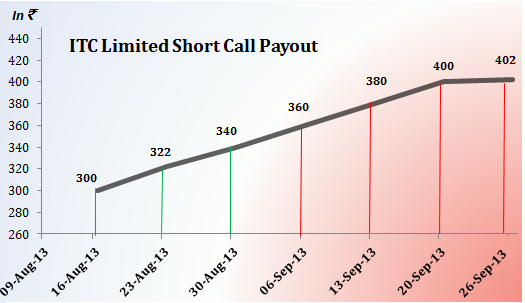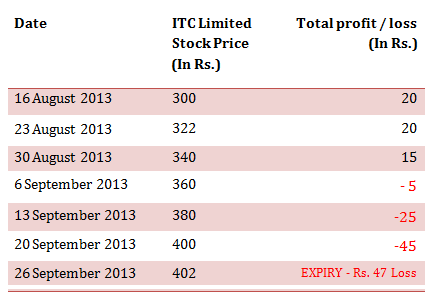When to use: When you are Bearish and anticipate the stock / index to fall.
How it works: Suppose, you are bearish on ITC Limited stock on 16th August 2013, when the share trades at Rs. 324. You sell a call option (also called writing a call option) for a premium of Rs. 20, expiring 26th September 2013 with a Strike Price of Rs. 335.
Risk / Reward: If the price of ITC Limited stock stays below Rs. 335 (i.e. the strike price) until expiry, you will retain the entire premium amount (i.e. Rs. 20). If however the price rises above Rs. 335, the buyer of call option may exercise his option and make a profit based on how far above Rs. 355 does the stock price rise. From the perspective of the seller of the call (you), you will start suffering a loss once the stock price rises above Rs. 355 (i.e. the strike price + premium).
When you short (or write) an option contract your risk is unlimited, as the stock may rise to any level while your reward is limited to the amount of premium (i.e. Rs 20 in the example) which is the maximum profit which you stand to gain from this trade.
The Chart illustrates your payout on given dates and prices (the table below assumes a scenario where the option gets exercised before expiry. Note that in the first two scenarios the option can not be exercised as the price of ITC Limited is below the strike price):
As you can see above, the option buyer will not exercise his option so long as the price stays below Rs. 335 (i.e. the strike price). Once the price rises above Rs. 335, the option buyer may exercise his option and you may lose part of the premium you earned depending on how far above Rs. 335, the price rises when the option gets exercised. If the option is exercised after the price rises above Rs. 355, you will start making a loss. If you hold on to your position until expiry, it will be settled based on the difference between the closing price of ITC Limited share and the strike price.
Note: The example and calculations are based assuming a single share though in reality options are based on lots of many shares. For example ITC Limited call option contract is for 1000 shares. Accordingly the premium you receive will be Rs. 20,000 for a single lot (i.e. 20 *1000) in our example.
Also Note: Unlike the buyer of an option who only pays the premium to buy the option, the seller of an option must deposit a margin amount with the exchange. This is because he takes an unlimited risk as the stock price may rise to any level. In case the price rises sharply above the strike price, the exchange utilises the margin amount to make good the profit which the option buyer makes. The amount of margin is decided by the exchange and it typically ranges from 15 % 60 % based on the volatility in the underlying stock and market conditions. In the above example, as a seller of call option, you will have to deposit a margin of Rs. 52,662 (i.e. Strike price * Lot size * 15.72%) for selling/writing a single lot of ITC Limited call option. Note that the total value of your outstanding position in this case will be Rs. 3,35,000 (i.e. strike price * lot size).
In Practice: In practice, traders do not wait until expiry to unwind their position. You (can) square off your position before the expiry of the contract. This is done by buying the same number of call options which you sold of the same underlying stock and same expiry date. So for example if you sold 1 call option contract of ITC Limited (lot size 1000 shares) at a strike price of Rs. 335 @ a premium of Rs. 20 (i.e. you will receive Rs. 20,000 as premium for the whole contract) expiring 26th September 2013; you can square off your position by buying the same call option contract (i.e. strike price Rs. 335, expiring 26th September 2013). The difference between the premium at which you sold the Options and the premium at which you bought it, will be your profit or loss.
In case the option gets exercised (by the option buyer) on or before the expiration date, your profit or loss will be calculated, based on the difference between the strike price and the closing market price on the day the option is exercised. In case there is a loss, it is adjusted against the margin which you deposited and the balance margin will be credited to your account. If you do nothing until expiry, your position will be settled by the stock exchange.
How to use the Short Call Option Strategy Excel calculator
Just enter your expected spot price on expiry, option strike price and the amount of premium, to estimate your net pay-off from the Short Call Option Strategy.




Is it true that, mostly , option sellers only make money thru using strategies? Is this true as per your standards (Reply honestly pls.
Why in India,there are no small lots for retail traders?
Not true, though option strategies are a great way once you learn them well.
Hi sir,
Your explanation of various strategies with examples made it very easy for me to understand considering that I am a beginner.
Thanks